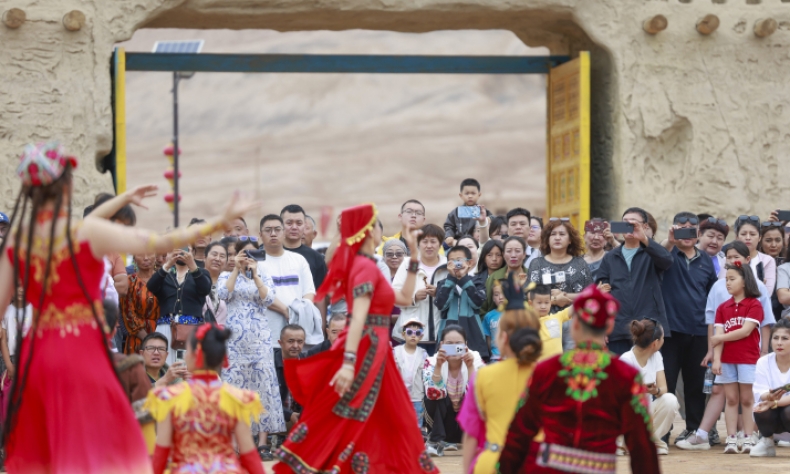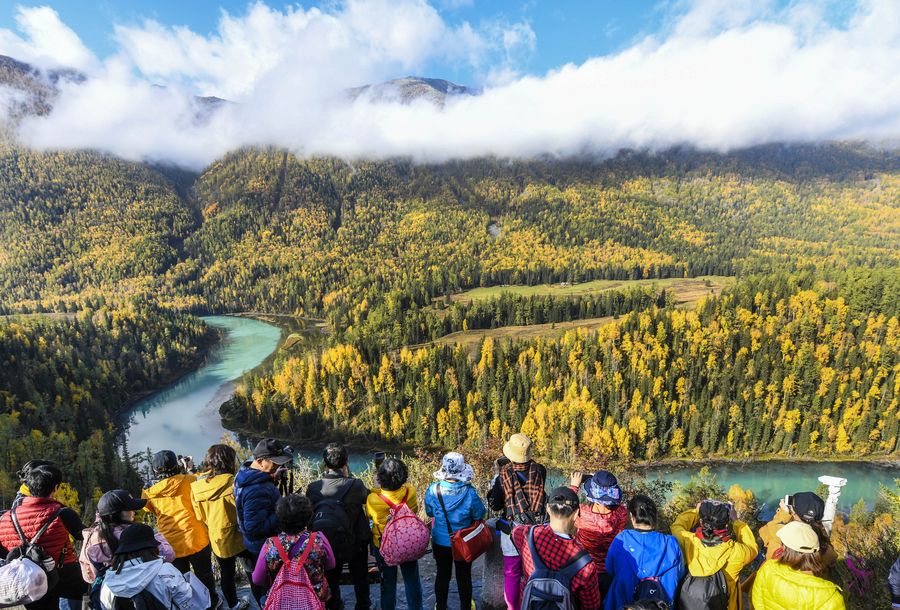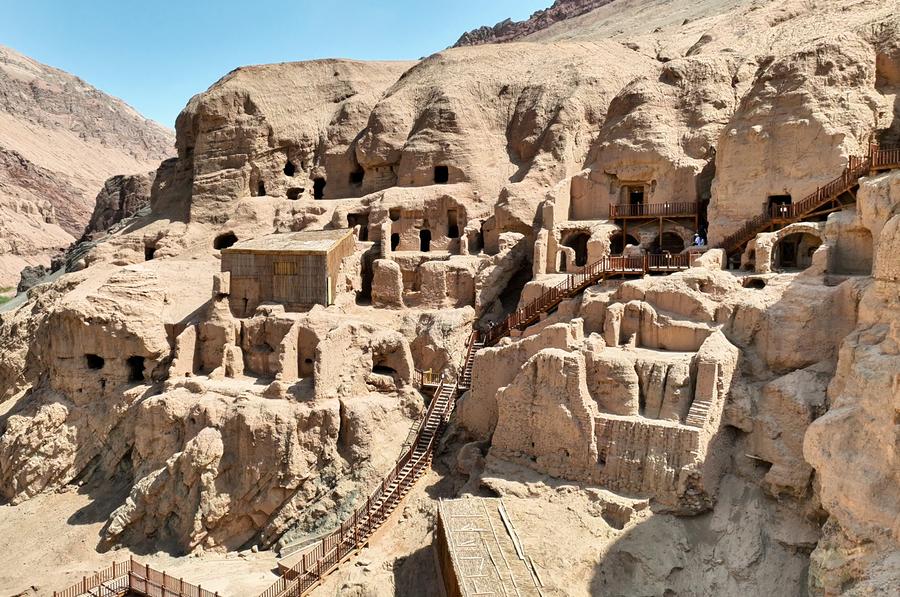Western Wonderland

The ancient historical and cultural relics on the Silk Road, along with its rich intangible cultural heritage, serve as unique and attractive cultural symbols that showcase Xinjiang’s distinctive character.
Located at the heart of the Eurasian continent, Xinjiang offers an endless supply of breathtaking landscapes, rich cultural heritage and unforgettable adventures. From the snow-capped Tianshan Mountains to the golden sand dunes in the Taklimakan Desert, Xinjiang is a paradise for travelers seeking both natural beauty and cultural depth.
Official statistics show that the region received a record 300 million tourist visits in 2024, a 14-percent increase compared to the previous year. Its tourism revenue reached around 355 billion yuan ($49 billion) last year, a 21-percent year-on-year rise.
Natural beauty
Covering one sixth of China’s total land area, Xinjiang is full of magnificent landscapes, from towering peaks and deep gorges to expansive deserts and tranquil lakes.
The Tianshan Mountain Range cuts through center of the region, offering spectacular scenery and world-class hiking opportunities. At its heart lies Tianchi Lake, also known as Heavenly Lake, a pristine waterbody surrounded by dense forests and towering peaks, often compared to Alpine lakes in Switzerland. In recognition of its significance, the Tianchi Scenic Area was inscribed on the UNESCO World Heritage List in 2013.
Further north, Kanas Lake captivates visitors with its ever-changing colors—from deep blue to emerald green—set against a backdrop of lush valleys and traditional villages. The area is especially famous for its vibrant autumn colors, attracting photographers from around the world.
Meanwhile, the Turpan Depression, China’s lowest point, features the otherworldly Huoyan (Flaming) Mountains, where temperatures soar to over 45 degrees Celsius in summer and the red sandstone cliffs glow under the intense sun. The temperature on the surface of the sand dunes can reach as high as 70 degrees Celsius.
For those seeking adventure, Xinjiang offers activities such as camel trekking in the Taklimakan Desert, China’s largest desert and the world’s second largest shifting sand desert, where travelers can experience the vastness of this arid landscape. Additionally, visitors can enjoy water rafting on the Ili River, navigating through thrilling rapids while surrounded by stunning natural scenery.

Cultural mosaic
Xinjiang has long been a location where multiple ethnic groups live together and various cultures and religions converge, acting as an important hub for the exchange between Eastern and Western civilizations. The ancient historical and cultural relics on the Silk Road, along with its rich intangible cultural heritage, serve as unique and attractive cultural symbols that showcase Xinjiang’s distinctive character.
In recent years, many places in Xinjiang have made great efforts to explore the modern value of their cultural heritage, transforming historical symbols into experiential and shareable cultural IP. These initiatives aim to enhance the visibility and attractiveness of Xinjiang’s rich cultural landscape.
In May, the Tuyugou Grottoes, a millennium-old relic in the city of Turpan, opened to the public for the first time after archaeological excavations. Located at the intersection of the central and northern routes of the ancient Silk Road, the site includes 157 caves, three ground-level temples and nine stupas dating back to the fifth century, along with a wealth of archaeological finds, including multilingual Buddhist manuscripts and secular documents related to household registration, taxation records and loan contracts.

In recent years, the government has invested over 77 million yuan ($10 million) in the protection, restoration and reinforcement of the grottoes. “The Tuyugou Grottoes are a vivid testimony to the cultural and religious exchanges in the Turpan Basin,” Xia Lidong, an associate research fellow at the Institute of Archaeology, Chinese Academy of Social Sciences, told Xinhua News Agency.
Five caves and a Buddhist temple at the site have been opened to the public, offering 300 visitor slots every day.
The Qiuci culture in Kuche (Kuqa), a city in Aksu Prefecture with a rich heritage and a long history, has also been popular among domestic and international travelers. The ancient region of Qiuci (modern-day Kuche) was a crucial hub for trade and cultural exchange along the Silk Road. It blended Chinese, Indian, Greek, Roman and Persian influences.
The Qiuci culture encompasses a wide range of artistic expressions, including ancient Buddhist traditions, exquisite grotto murals, vibrant music and dance, traditional opera, valuable artifacts and poetry. These elements together represent a shared cultural heritage of humanity, highlighting the region’s historical significance and artistic achievements.
To promote awareness of Qiuci culture, local authorities have organized various themed activities, such as festival celebrations, exhibitions and performances. These initiatives aim to engage both locals and visitors, fostering a deeper appreciation for the unique cultural legacy of Kuche and its role in the broader context of Silk Road history.
Improving convenience
Xinjiang is also focusing on developing world-class tourist destinations, resorts and other tourism-related infrastructure. Key scenic roads, such as the 561-km Duku Highway that traverses the Tianshan Mountains from north to south and crosses four climate zones, have been upgraded into top self-driving routes.
Improved transportation, including expanded domestic and international flight routes and rural road renewal projects, is set to further boost the region’s tourism growth. This year, Xinjiang plans to invest 80 billion yuan ($11 billion) in road transportation infrastructure, representing a 13.5-percent increase compared to last year.
In recent years, Xinjiang has emerged as a prime destination for winter sports enthusiasts, thanks to its abundant ice and snow resources.

A number of high-grade ski resorts have been constructed, making the autonomous region a hub for skiing and snowboarding. The Tianshan Tianchi International Ski Resort, the Koktokay International Ski Resort and other destinations offer state-of-the-art facilities and services. These resorts cater to a wide range of skill levels, from beginners to advanced skiers, making winter sports accessible to more people than ever.
Across Xinjiang, many localities host cultural and tourism activities, and offer promotional policies, such as discounts on entrance tickets and accommodation, to draw tourists and stimulate market vitality.
To make travel more convenient for international tourists, Wang Juan, deputy head of the cultural, broadcasting, television and tourism bureau of Urumqi, capital city of Xinjiang, highlighted at a press conference in late April that “432 multi-currency POS (Point of Sale) machines have been installed across the city, along with 17 foreign currency exchange points and a number of foreign exchange automated teller machines. These facilities are widely available in major tourist attractions, resorts, theaters, leisure streets, night-time cultural consumption areas and star-rated hotels. Tourists from all over the world can easily make payments while shopping, dining or visiting attractions.”
All the aforementioned efforts have seen tangible results. According to the regional culture and tourism department, Xinjiang received a total of 44.63 million tourist visits in the first quarter (Q1) of 2025, up 9.08 percent year on year.
Thanks to multiple initiatives to boost the cultural sector and the tourism market, tourist spending reached 49 billion yuan ($6.84 billion) over the same period, a year-on-year increase of 12.58 percent.
More than 21,600 public cultural activities were held in Q1, drawing the participation of over 8.24 million people.
As Xinjiang continues developing its tourism infrastructure while preserving its cultural heritage, this vast region stands poised to become Asia’s next great travel destination–where ancient traditions meet modern comfort against some of Earth’s most dramatic backdrops.
 Facebook
Facebook
 Twitter
Twitter
 Linkedin
Linkedin
 Google +
Google +










